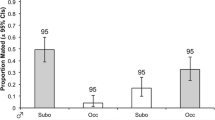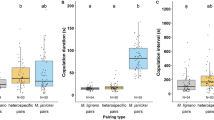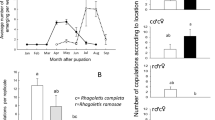Abstract
Rhagoletis completa Cresson and Rhagoletis zoqui Bush, are two sister species in the suavis group that were thought to occupy non-overlapping geographical ranges. Recent discovery of a contact zone in North Eastern México where natural interspecific hybrids with intermediate morphotypes can be found has led to laboratory studies in small enclosures that failed to identify the existence of reproductive barriers capable of maintaining the genetic integrity of both species. Because the experimental approach used in such studies could have interfered with natural behavior of flies, a series of additional mating compatibility tests under much less restrictive conditions were performed. Our observations, confirmed the fact that males and females of both species engage in interspecific matings. However, R. completa females were more reluctant to engage in heterospecific matings than R. zoqui females, revealing asymmetries in sexual isolation. Also, careful scrutiny of male guarding behavior and species specific partitioning of mating location unveiled subtle differences that could result in reproductive isolation if reinforced during secondary contact.







Similar content being viewed by others
References
AliaNiazee MT (1988) Diapause modalities in some Rhagoletis species. Special report. Oregon State University, Agricultural Experiment Station. Oregon State University, Corvallis, OR. 830:13–25
Aluja M, López M, Sivinski J (1998) Ecological evidence for diapause in four native and one exotic species of larval-pupal fruit fly (Diptera: Tephritidae) parasitoids in tropical environments. Ann Entomol Soc Am 91:821–833
Aluja M, Piñero J, López M, Zuñiga A, Piedra E, Fleischer F, Sivinski J (2000a) New host plant and distribution records in México for Anastrepha spp., Toxotrypana curvicauda Gesrtacker, Rhagoletis zoqui Bush, Rhagoletis sp., and Hexacheeta sp. (Diptera: Tephritidae). Proc Entomol Soc Wash 102:802–815
Aluja M, Piñero J, Jácome I, Díaz-Fleischer F, Sivinski J (2000b) Behavior of flies in the genus Anastrepha (Trypetinae: Toxotrypanini). In: Aluja M, Norrbom AL (eds) Fruit flies (Tephritidae): phylogeny and evolution of behavior. CRC, Boca Raton, pp 375–406
Aluja M, Lozada N, Piñero J, Birke A, Hernández-Ortíz V, Díaz-Fleischer F (2001) Basic behavior of Rhagoletis turpiniae (Diptera: Tephritidae) with comparative notes on the sexual behavior of Rhagoletis pomonella and Rhagoletis zoqui. Ann Entomol Soc Am 94:268–274
Arnqvist G, Edvardsson M, Friberg U, Nilsson T (2000) Sexual conflict promotes speciation in insects. Proc Natl Acad Sci 97:10460–10464
Bush G (1966) The taxonomy, cytology, and evolution of the genus Rhagoletis in North America (Diptera: Tephritidae). Bull Mus Comp Zool 134:431–562
Bush G (1968) Sympatric host race formation and speciation in frugivorus flies of the genus Rhagoletis (Diptera, Tephritidae). Evol 23:237–251
Bush G, Smith J (1998) The genetic and ecology of sympatric speciation: a case study. Res Popul Ecol 40:175–187
Conover WJ, Iman RL (1981) Rank transformations as a bridge between parametric and nonparametric statistics. Am Stat 35:124–129
Coyne JA, Orr HA (1989) Patterns of speciation in Drosophila. Evol 43:362–381
Coyne JA, Orr HA (1997) “Patterns of speciation in Drosophila” revisited. Evol 51:295–303
Coyne JA, Orr HA (2004) Speciation. Sinauer Associates, Sunderland
De Winter JCF, Dodou D (2010) Five-Point Likert Items: t test versus Mann–Whitney-Wilcoxon. A peer-reviewed electronic journal.15:11:ISSN1531-7714
Dobzhansky T (1937) Genetics and the origin of species. Columbia Univ, New York
Dobzhansky T (1940) Speciation as a stage in evolutionary divergence. Am Nat 74:312–321
Eason P, Hannon SJ (1994) New birds on the block-new neighbors increase defensive costs for territorial male willow ptarmigan. Behav Ecol Sociobiol 34:419–426
Edelaar P, Siepielski AM, Clobert J (2008) Matching habitat choice causes directed gene flow: a neglected dimension in evolution and ecology. Evol 62:2462–2472
Foote H (1981) The genus Rhagoletis loew south of the United States (Diptera: tephritidae). USDA 1607:75
Futuyma DJ (1989) Macroevolutionary consequences of speciation: inferences from phytophagous insects. In: Otte D & Endler J (eds) Speciation and its Consequences. Sinauer, Sunderland, Massachusetts, pp 557–578
Hendrichs J, Katsoyannos BI, Wornoayporn V, Hendrichs MA (1994) Odour-mediated foraging by yellow jacket wasps (Hymenoptera: Vespidae): predation on leks of pheromone-calling Mediterranean fruit fly males (Diptera: Tephritidae). Oecologia 99:88–94
Hernández V (1985) Descripción de una nueva especie mexicana del género Rhagoletis Loew (Diptera Tephritidae). Folia Entomol Méx 64:73–79
Hood GR, Egan SP, Feder JL (2012) Evidence for sexual isolation as a prezygotic barrier to gene flow between morphologically divergent species of Rhagoletis fruit flies. Ecol Entomol. doi:10.1111/j.1365-2311.2012.01392.x
Hoskin CJ, Higgie M, McDonald KR, Moritz C (2005) Reinforcement drives rapid allopatric speciation. Nature 437:1353–1356
Jennings J, Mazzi D, Ritchie M, Hoikkala A (2011) Sexual and postmating reproductive isolation between allopatric Drosophila montana populations suggest speciation potential. BMC Evoly Biol http://www.biomedcentral.com 11:68/1471-2148
Kaneshiro K (1976) Ethological isolation and phylogeny in the plan tibia subgroup of Hawaiian Drosophila. Evol 30:740–745
Kaneshiro K (1983) Sexual selection and direction of evolution in the biosystematics of Hawaiian Drosophilidae. Ann Rev Entomol 28:161–178
Kiester AR (1979) Conspecifics as cues: a mechanism for habitat selection in the Panamanian Grass Anole (Anolis auratus). Behav Ecol Sociobiol 5:323–330
Kondrashov A, Kondrashov F (1999) Interactions among quantitative traits in the course of sympatric speciation. Nature 400:351–354
Korol A, Rashkovetsky E, Iliadi K, Michalak P, Ronin Y, Nevo E (2000) Nonrandom mating in Drosophila melanogaster laboratory populations derived from closely adjacent ecologically contrasting slopes at “Evolution Canyon”. Proc Natl Acad Sci 97:12637–12642
Korol A, Rashkovetsky E, Iliadi K, Nevo E (2006) Drosophila flies in “Evolution Canyon” as a model for incipient sympatric speciation. Proc Natl Acad Sci 103:18184–18189
Lukhtanov V (2011) Dobzhansky’s rule and reinforcement of prezygotic reproductive isolation in zones of secondary contact. Biol Bull Rev 2:2–12
Mallet J (2005) Hybridization as an invasion of the genome. Trends Ecol Evol 20:229–237
Manning WE (1957) The genus Juglans in Mexico and Central America. J Arnold Arboretum 38:121–150
Mayr E (1963) Animal species and evolution. Harvard UP, Cambridge
Noor MAF (1999) Reinforcement and other consequences of sympatry. Heredity 83:503–508
Nosil P, Crespi BJ, Sandoval CP (2003) Reproductive isolation driven by the combined effects of ecological adaptation and reinforcement. R Soc Lond 270:1911–1918
Opp SB, Spisak SA, Telang A, Hammond SS (1996) Comparative mating systems of two Rhagoletis species: the adaptive significance of mate guarding. In: McPheron BA, Steck GJ (eds) Economic fruit flies: a world assesment of their biology and management. St. Lucie Press, Delray Beach, pp 43–49
Perez P, Calcagno J, Lovrich G (2011) Absence of a prezygotic behavioural barrier to gene flow between the two sympatric morphs of the squat lobster Munida gregaria (Fabricius, 1793) (Decapoda: Anomura: Galatheidae). Helgol Mar Res 65:513–523
Perfectti F (2002) Especiación: modos y mecanismos. In Soler M (ed) Evolución: la base de la biología. Proyecto Sur, Granada, Spain, pp 307–322
Prokopy R, Papaj D (2000) Behavior of flies of the genera Rhagoletis, Zonosemata, and Carpomya (Trypetinae: Carpomyina). In: Aluja M, Norrbom AL (eds) Fruit flies (Tephritidae): phylogeny and evolution of behavior. CRC, Boca Raton, pp 219–252
Ritchie M (2007) Sexual selection and speciation. Annu Rev Ecol Evol Syst 38:79–102
Rull J, Aluja M, Tadeo E, Guillen L, Feder J (unpublished) Distribution and host plant affiliation of walnut-infesting Rhagoletis (Diptera: Tephritidae) in Mexico
Rull J, Aluja M, Feder J, Berlocher S (2006) Distribution and host range of hawthorn-infesting Rhagoletis (Diptera: Tephritidae) in Mexico. Ann Entomol Soc Am 99:662–672
Rull J, Aluja M, Feder JL (2010) Evolution of intrinsic reproductive isolation among four North America populations of R. pomonella. Biol J Linn Soc 100:213–223
Rull J, Tadeo E, Aluja M, Guillen L, Egan S, Feder J (2012) Hybridization and sequential components of reproductive isolation between parapatric walnut-infesting sister species Rhagoletis completa and Rhagoletis zoqui. Biol J Linn Soc 107:886–898
Servedio MR, Noor MAF (2003) The role of reinforcement in speciation: theory and data. Ann Rev Ecol Evol Syst 34:339–364
Smith J, Bush G (1997) Phylogeny of the Genus Rhagoletis (Diptera: Tephritidae) inferred from DNA sequences of mitochondrial cytochrome oxidase II. Mol Phylogenet Evol 7:33–43
Stamps J, Buechner M, Alexander K, Davis J, Zuniga N (2005) Genotypic differences in space use and movementpatterns in Drosophila melanogaster. Anim Behav 70:609–618
Yuval B, Hendrichs J (2000) Behavior of flies in the genus Ceratitis (Dacinae: Ceratitidini). In: Aluja M, Norrbom AL (eds) Fruit flies (Tephritidae): phylogeny and evolution of behavior. CRC, Boca Raton, pp 429–456
Acknowledgments
We are thankful to Emilio Acosta (Instituto de Ecología, A.C., Xalapa, Veracruz, México [INECOL]) for technical help during collections of biological material and to Dr. Armando Martínez Chacón (Instituto de Neuroetología, Universidad Veracruzana) for advice on statistical analysis of results. Eduardo Tadeo acknowledges a PhD scholarship from CONACyT during the course of this study. Juan Rull acknowledges funding by CONACyT (CB 2005-25889-50008Q).
Author information
Authors and Affiliations
Corresponding author
Rights and permissions
About this article
Cite this article
Tadeo, E., Aluja, M. & Rull, J. Alternative Mating Tactics as Potential Prezygotic Barriers to Gene Flow Between Two Sister Species of Frugivorous Fruit Flies. J Insect Behav 26, 708–720 (2013). https://doi.org/10.1007/s10905-013-9383-7
Revised:
Accepted:
Published:
Issue Date:
DOI: https://doi.org/10.1007/s10905-013-9383-7




